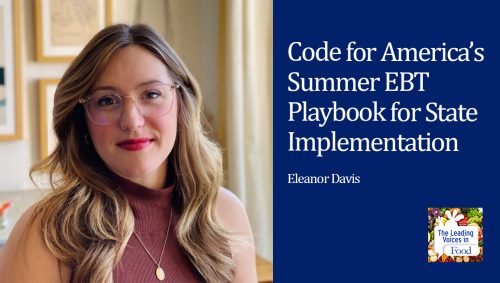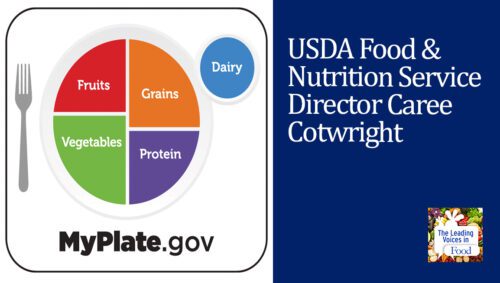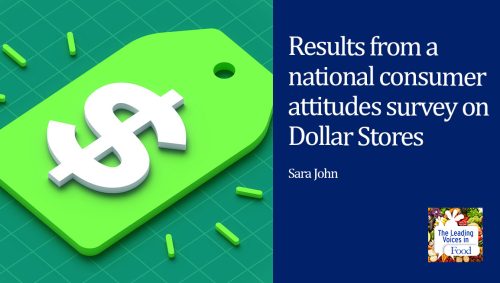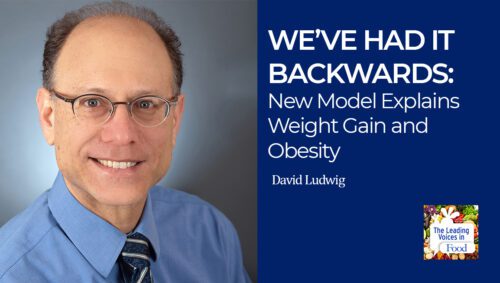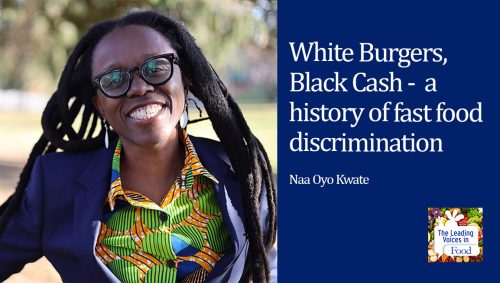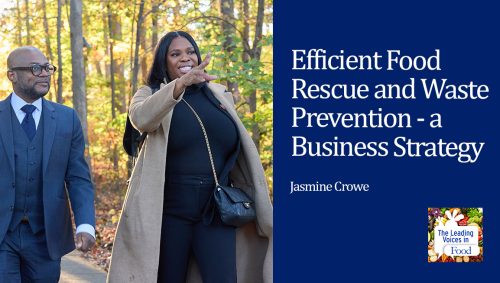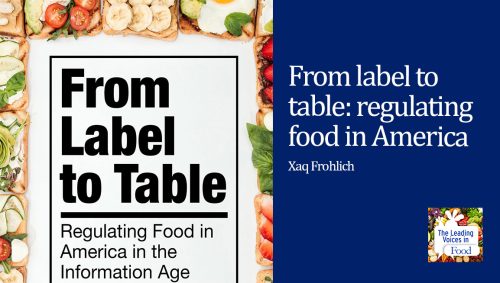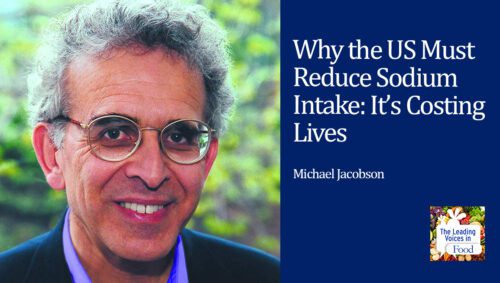The Leading Voices in Food
E6: Shiriki Kumanyika on the Disparities in our Food
Is it fair or ethical to allow food companies to target low-income communities with marketing for unhealthy foods? Should the health of our communities take a back seat to industry profits? These are surprisingly difficult questions we’ll explore today with Dr. Shiriki Kumanyika on The Leading Voices in Food.
Subscribe: Apple Podcasts | TuneIN | Google Podcasts | SoundCloud | PocketCasts | Radio Public
Tags: Child Development & Nutrition | Childhood Obesity | Diet & Nutrition | Eating Disorders | Equity, Race & Food Justice | Food Industry Behavior & Marketing | Obesity | Ultra-processed Food & Additives |

Dr. Shiriki Kumanyika is a research professor in the Department of community health and prevention at the Dornsife School of Public Health at Drexel University in Philadelphia, and also professor Emerita of epidemiology at the University of Pennsylvania Perlman School of medicine. Shiriki holds degrees in human nutrition and public health and in social work. She is the founder and chair of the Council on Black Health, formerly known as the African American collaborative obesity research network, which develops and promotes solutions that achieve healthy black communities. Shiriki’s research over more than three decades focuses on prevention and management of obesity and other diet-related diseases and on solutions to disparities in these diseases. Shiriki serves as a nutrition adviser to the World Health Organization, is co-chair of the policy and prevention section of the World Obesity Federation, and a member of the Lancet Commission on obesity.
Interview Summary
You’ve been a hero for addressing diet, weight, and health-related issues in the context of disparities and inequality. These are very important issues. Can you explain why these issues are so important and what some of the key matters are that we should be considering going forward?
Sure. Well, obesity, I think, has taken societies globally by surprise in that it used to be considered a problem of a few people who couldn’t control what they eat, or something like that. That was the perception. And now, it’s really become a major societal problem in the US and similar countries, but also in places like the Middle East and low- and middle-income countries. And even in Africa, Sub-Saharan Africa, which didn’t have a high prevalence of obesity before, but it’s been going up. And my interest in the inequality issues has been related to a phenomenon of higher obesity prevalence in populations that are socially disadvantaged—particularly racial and ethnic minority populations in the US and in other countries like the UK and some European countries. And I think one of the reasons that it’s so important is that the way we are approaching the epidemic now relates to societal changes, and really looking at the environments that lead to people’s inability to control their weight at the population level, not just a few individuals. That’s going to be especially important because the circumstances that promote high obesity prevalence are more common in the population groups that have more obesity and that are socially disadvantaged. And so, I think that although it used to be thought that, let’s say American Indians or black Americans or black women were in groups that were somehow just defective or unable to control weight—now that the epidemic has reached children and adults in the population at large–we’re getting attention to some of these issues. So the challenge is to make sure that the attention that we’re getting reaches the communities who have the most of the problem.
What are some examples of things that might be done to accomplish that goal?
I think I’ll refer to something that was just published. Some of the things that are being done are the policies and systems changes that you know well. I mean, we’ve been talking it about ever since I think you coined the term: the toxic environment. Really changing things in the food system, changing where people get food and how ideas are promoted and what foods are given to children in school meals. As much as we can do on the food side. And then also changing things about physical activity. Things that affect how many calories people are expending every day so that there’s a calorie balance and people are able to maintain their weight. The things that people have seen like menu labeling–to help people understand how many calories are in their food. And, some of the guidelines for what kinds of foods are allowed for people who are participants in the WIC program. And that program is particularly targeted to low-income women and their children. And then, there’s a lot of discussion about changes to SNAP—you know, what used to be called the food stamp program. Because that is a source of income for people to buy foods, there’s been a lot of policy discussion about whether there should be some way of making it more likely that people will be using those resources for healthier foods.
Many people think that obesity and then food insecurity, or what used to be called malnutrition, are opposite sides of the coin. But in fact, they can coexist and there can be a common set of social drivers and certain groups can be especially vulnerable to both. Can you say a little bit more about that?
Yes. I think that those things are coming together more and more, again, both in the US and globally because as it turns out, the foods that are easiest to afford for people with very low incomes and maybe even sporadic incomes are also the ones that are ultra-processed foods that are high in calories and fat. And the resources to actually use those foods well in terms of cooking facilities—a stable home life—are also less likely to occur in some of the populations that are at high risk. So, the same aspects of the food system have effects on people with limited food choices and also for people who don’t have those limits but are sort of bombarded with marketing of unhealthy foods. And I think I wanted to add when you asked what could be done about this, that these are some of the things that we think can be done. Including getting to food pantries, for example, where people with food insecurity might go to have healthier foods.
These things don’t seem to be working as well as we thought maybe five, six years ago. So that’s a concern. And that’s why I mentioned we have to make sure that we’re getting to the people who need them the most. The Healthy Communities Study data—this is a large study in 130 communities just documenting what types of things people are doing with some of these policies and changes—and the findings of this study for three or four different main results papers show that the things that were working best for child obesity were working most clearly in the Northeast and in high income and white communities. And they’re not really reaching the other communities, those in greatest need.
One of the things that you just mentioned that I find especially fascinating is your work on targeted marketing. Can you explain what this concept is and why it’s important?
Yes. This is target marketing and has become a preoccupation of mine. I think recently I find myself talking about it more and more and trying to convince public health professionals and researchers to pay more attention to it. So, to try to give a quick summary of what target marketing is: it’s the common business practice of trying to identify groups in the population or segments that are most likely to want and buy your product and then making sure that the marketing is addressed to those groups. And when I say target marketing—that’s a general practice in marketing and it’s not just food advertising, although that’s what comes to mind mostly. It’s also where the stores are, but then in the store, what kind of products are thought to appeal to the population shopping there and how they might be positioned and so forth.
And I’ve been interested in it because one of the ways that marketers can identify a segment is with their demographic characteristics, and so race and gender and age are used freely as a segmentation strategy. And unfortunately, it’s extremely easy to document that food products that are less healthy and beverage products that are less healthy are more heavily marketed to the same communities and the same populations that happen to have high rates of obesity and some of the obesity-related diseases. So that’s the targeting that I’ve been interested in and trying to sort out what to do about that targeting. Because I think it’s really a barrier to the effectiveness of any efforts we have in trying to improve the food circumstances and diets of the high-risk populations.
Is the increment in marketing to some disadvantaged populations a little bit? A lot? Put it in context for us if you would?
I think it’s a lot. It’s partly a lot because there are several aspects of marketing that work together in targeting a particular community. So let’s say a common finding is that a certain type of ad for say a sugar-sweetened beverage or a particular type of snack food or breakfast cereal may be twice as likely (the TV ad)—its twice as likely to be seen by a black child, based on the Nielsen viewing data, than a white child. So, you have that. But then you also have a geographical area where that child lives targeted in the form of the types of products that are available. Sometimes products are priced really to be extremely affordable so that a healthier option couldn’t compete. And then there are these other aspects of marketing like special websites and sponsorships. So, a lot of the same companies that heavily market products that don’t have a good nutrient profile to black communities, for example, are also the same companies that would appear to have the interests of these communities at heart, because they pour a lot of money into the communities in terms of educational programs and sponsorships. So, it really then creates loyalty and a sense that “these companies are for us.” And when their products and their brands appear, the people are often influenced, it’s like a perfect storm.
This targeted marketing is such an interesting topic. Before I’ve heard you talk about that there’s an interesting social history to some of this where there was a time when the communities that now might be targeted were actually interested in having more marketing directed at them. Could you explain how that worked?
Sure. Well, so back in the days when things were segregated, and it was common to think of Negroes, for example, as a different kind of people, you know, and not the same, as not necessarily good customers. Some companies discovered that there was a lot of money in the black community, in the “Negro market,” and began to market specifically their products. There is one video, I think it’s in one of the beverage companies, that you see that these proud salesmen—black salesmen who couldn’t even sleep in a hotel in the South because everything was segregated—but they were so proud to be salesmen and out there selling products. And so, it’s, it’s kind of–it’s like civil rights or a recognition issue of being valued in the marketplace and being seen. And I experienced that even as a child—that I didn’t see products that had pictures on them that looked like me or if I did, they were not necessarily appealing pictures. And so, it was a long time before the marketers really began to say: “these are customers.” And we can, if we appeal to these customers, we can make money with them. So that’s kind of what it is. It’s a mixed blessing in that sense because not all of the products that are perceived to be—I guess most of the products that are perceived to be the best to sell are the less healthy products.
What are some of the thoughts you have about possible solutions to the targeted marketing problem?
Actually, I am having some new thoughts about this, partly referring back to an article from 1996. It’s funny because people say don’t cite anything that’s more than five years old. But there is a lot of good stuff in things that were written back, decades ago that haven’t really been implemented. And this is also a problem in tobacco and alcohol marketing. An early paper in this field from 1996 by Jerome Williams and some of his colleagues, (Jerome was a marketing researcher) asks the question of: “Is this good business or is it racism?” “Are people really being preyed upon by marketers or is this just a coincidence of the fact that they’re looking for a segment that will use products?” And they focused on blacks and Hispanics and alcohol and tobacco marketing. In that article, they offer a framework for thinking through what to do about target marketing. And my thoughts are really turned more to looking at targeting because there are more populations than just minority groups. I mean targeting to women—tobacco things targeted to women to raise their smoking rates and so forth. And targeting to children in the food area has been a big issue, as well as targeting of other types of products that might be considered harmful. So, I’ve been thinking that what we’ve been spending our time on–we being public health researchers—is documenting the fact that this targeting of harmful products exists, and we haven’t been connecting the dots in terms of does this marketing really cause harm? And because yeah, probably it seems so obvious that you would show that it exists, and people get shock value. I mentioned the two to one ratio, but sometimes the ratio of ads seen, or other things related to target marketing is much higher than that—with the ads culturally tailored to have the greatest salience.
So, you see this, and you think, wow, and then, so what can we do about this; and you come up empty. So, I’m thinking that a more refined research agenda that really asks, in an open-minded way, what is the harm coming from this? And, in this article that I mentioned, to separate the effect of the marketing from the intent of the marketing. Because if you say, well, this is just good marketing, these companies don’t mean to harm and look at all the good they’re doing for communities—that’s not the right question anymore. As I’m thinking about it now, it’s really more: is the effect of this marketing disproportionate in terms of, say, how much the particular population group was using the product before—are you actually raising the level of use of a harmful product, and what is the overall harm?
What’s the moral compass in marketing that one can find around the issue of harm? And then really work on that and connect the dots with the research to show where the harm is occurring and approach it that way. And maybe there has been some work like that, but I’ve not seen a lot of documentation. I haven’t seen as much of this type of argument, and I think it’s better to come to include all types of target marketing of healthy products, all audiences, so it doesn’t put a stigma on minority groups for example, or low-income populations as if they somehow need special protection from marketers now, which is kind of a paternalistic, derogatory impression.
You were saying that the health impacts or the use of the product needs to be documented in these groups, but couldn’t you just assume that it’s having a negative impact? I mean the why would the companies be spending all the money marketing if it weren’t driving up use of these products, and if consumption of certain categories of things like sugar-sweetened beverages has been shown to have negative health impacts, then the two to one ratio you mentioned–the minority than non minority populations receiving an exposure of this marketing is occurring. Can’t you just assume it is bad and set about trying to do something about it?
Yeah, I think that from a public health perspective you could assume that. But in the society we are living in, there are a lot of things that trump a public health perspective; and in a free market mode and with the profit motive and the amount of money that’s involved with food as a big business, you have to make the case. And so, I think that’s what I’m saying. I don’t think we’ve been willing to have to prove the case because it’s such an obvious connection. But some of the things that were suggested when I was, and I’ve been thinking about this, looking for new pathways to pursue to point out that a lot of our efforts to do this are still pretty blunt instruments. They’re not brand specific. They’re not necessarily segment-specific in a way that would really give us the kind of evidence that we need.
And I think policymakers, if they’re going to be any policies put in place, it’s going to be really tough. I mean, I think you know that the efforts before of trying to do something about marketing and put curbs on marketing have all failed, crashed and burned. But I’m so convinced that something has to be done to shift these patterns of marketing. If we’re ever going to be successful in general and in high-risk populations in improving diets of the population, we have to do something—and we need a new type of evidence that will influence policymakers and compete with the type of evidence that they’ll get about why this type of marketing is a good idea and that kind of stuff.
Do you see anything that you would consider particularly shiny spots in the nation’s efforts effort to address obesity?
I’m going to give you a weird answer Shiriki-type answer. I think that the shining spot is that we have been trying very hard to implement what we thought would work and are now possibly at a new inflection point. There’s more consideration being given to community engagement. There’s more consideration being given to broader social determinants and not thinking that our interventions are operating alone–but that the food system is connected to social care systems and economic systems, and physical activity is connected to transportation systems. So, I think that this movement towards a systems approach and toward more community engagement rather than formulating our solutions and sort of laying on hands and expecting them to work—I think that’s really a bright spot. Because I think the answers to a population problem like this are in the communities that are actually being affected. They know what their lives are like and can co-create some of the solutions that will then push back against the forces that are driving the epidemic.


